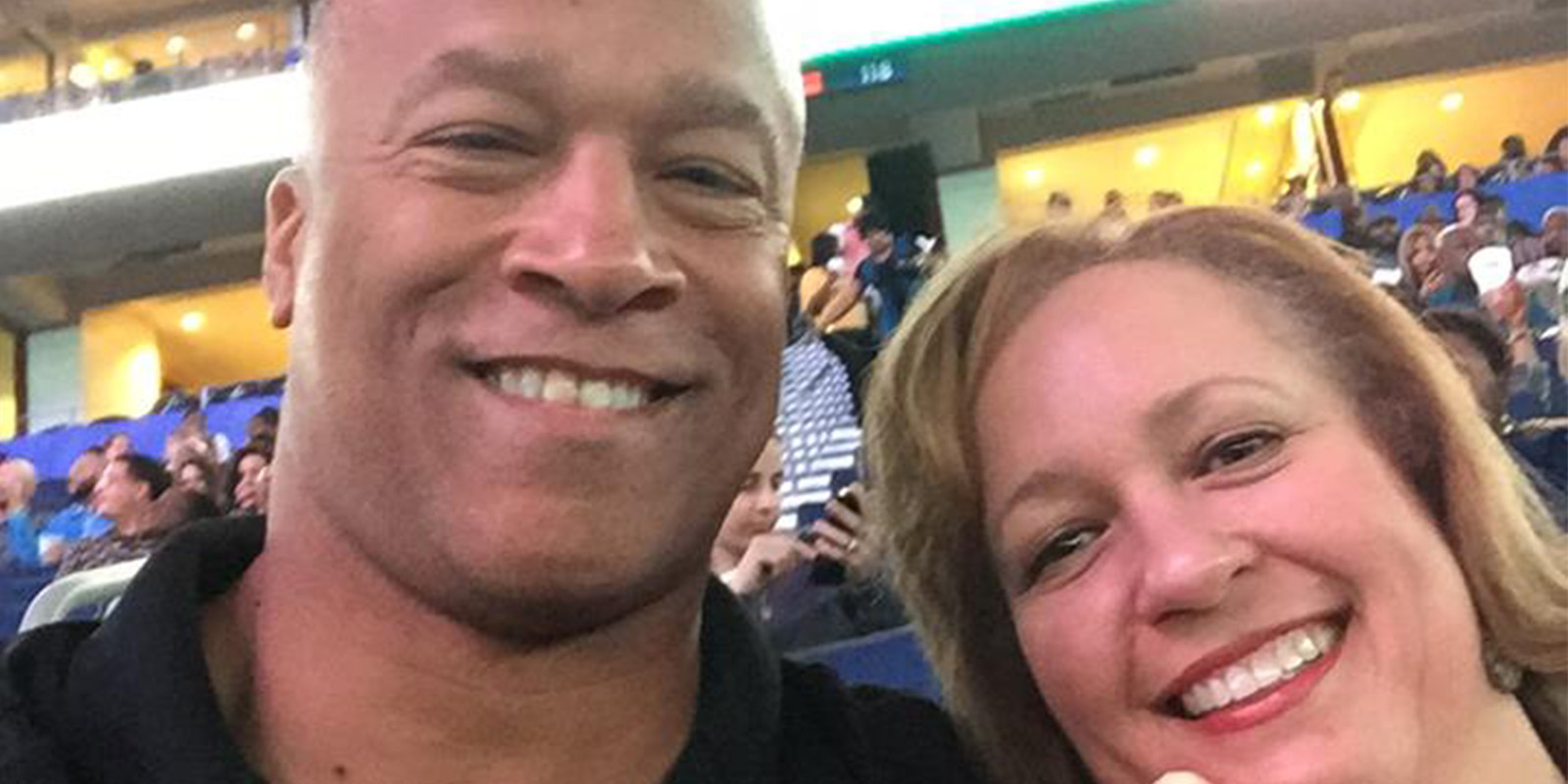
Ruth and Jerry Bell Keep Stepping Up to Help African-American Students at USF — First with a Scholarship, Now with the Black Leadership Network
Feb. 24, 2017
Inside the modern, warmly decorated home of Ruth and Jerry Bell, a mantle holds three small bronze busts and a jade oval that reveal a lot about the couple who resides here — yet offers no sign of what you might think would be most prominently displayed.
Each sculpture depicts a legendary African-American woman — Mary McLeod Bethune, the noted educator, philanthropist, civil rights activist and humanitarian who laid the groundwork for the creation of Bethune-Cookman University; Sojourner Truth, the famed 19th-century abolitionist and early women’s rights proponent; and Harriet Tubman, another iconic abolitionist who escaped slavery and later earned her place in history for rescuing enslaved families through the Underground Railroad.

And then there’s the unique jade artifact. Jerry, who runs his own information technology company, and Ruth, the senior vice president of public affairs at LifeLink Foundation Inc., purchased it on a trip to China several years ago. “It’s a globe inside a globe inside a globe, and it’s actually the Chinese symbol for 'happy family,' ” he says. “When I found that out, I had to have it. A happy family is all I’ve ever wanted.”
He and Ruth certainly have enjoyed that and more. There’s the loving family — including 27-year-old daughter Vanessa and 25-year-old son David — they have raised in this quiet Pasco County subdivision. But there is also the extended family they have gained at USF, thanks to the endowed scholarship they established more than a quarter of a century ago for black students in need of financial assistance.
It is one that will soon grow even larger with the launch of the Black Leadership Network, a new program they are deeply involved with to assist African-American students at USF — a development that holds deep meaning any time of the year, though especially during Black History Month. “It all came together through a natural progression of events,” says Ruth, who earned her master’s degree from USF. “And we’re so excited to be a part of it.”
Of course, there’s still another family important in Jerry's world: his former brethren from a past career that for five seasons made him a local sporting fixture. Even today, his name will ring a bell to Tampa Bay Bucs fans. You just won’t see any walls or shelves filled with framed photos, trophies or vintage orange-red-and-white jerseys adorned with No. 82. In spite of his high-profile days as a starting tight end with the Bucs from 1982-1986, he keeps a low profile when it comes to his football past — as a key member of the offense who caught passes from such familiar names as future Super Bowl MVP Doug Williams, NFL journeyman Steve DeBerg and eventual Hall of Famer Steve Young.
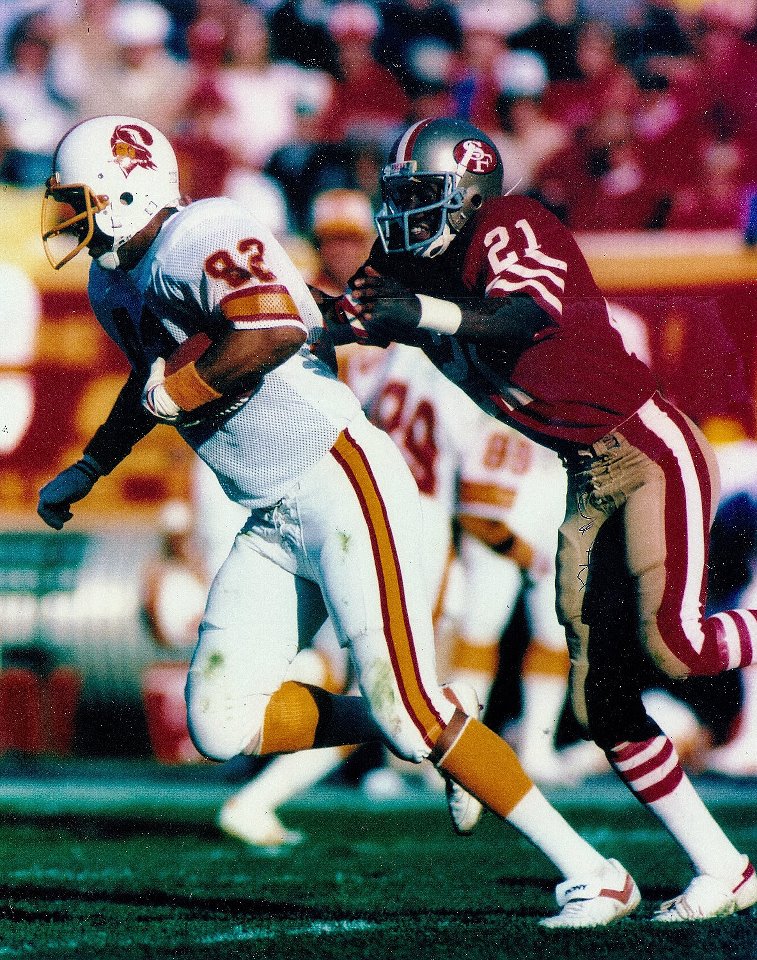
It’s not that he isn’t proud of his NFL tenure, which began as the No. 2-rated tight end coming out of college at Arizona State, featured with a playoff run in a strike-shortened rookie season of ’82, and followed with a string of tough losing seasons until a leg injury ended his career in ’86. On the contrary, he treasures the camaraderie and accomplishments from those years, and his calm, steady leadership made him a logical choice to serve for four years as president of the Tampa Bay chapter of the NFL Players Association.
But other than one faded action shot in a side room housing a piano, near a bronze bust of fabled jazzman Dizzy Gillespie, you have to ask where all the football memorabilia is.
“Let me show you,” he obliges, heading into the closet of his office and pulling out his old helmets from the Sun Devils and Bucs, and a dusty, otherwise unseen plaque. It was from the Tampa Chapter of the NFL Alumni, naming him the 1986 recipient of the Ricky Bell Award for Community Service. The award was presented in memory of the Bucs’ first franchise draft pick who died tragically at age 29 of a rare connective tissue disease. And it honored Jerry's behind-the-scenes work in the area — organizing food drives for the United Way, buying Bucs tickets for the Boys and Girls Clubs, tutoring black youths to help prepare them for the SATs and ACTs, and running his Jerry Bell football camps.
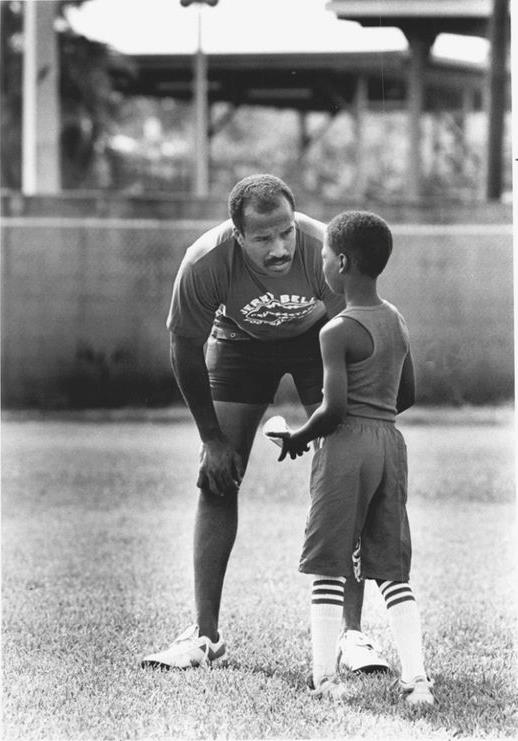
Jerry and Ruth were even featured in a 1984 United Way promotional video, showing them packing free groceries to deliver to families unable to buy their own. All these years later, the community service award still says a lot about who Jerry Bell is as a person, and why he doesn’t focus on the past. The simple truth is that he and Ruth have too much to think about and do in the present, with too much at stake in the future for those who can benefit from their help today. That’s where their endowed scholarship and involvement in launching the Black Leadership Network, supported by the USF Foundation, comes into play.
The latter program began to take shape last year at the annual Kente Awards Celebration, honoring members of the black community who have made an impact in the Tampa Bay area. It was there that Luz Randolph, the Foundation's Diversity Initiatives Officer, met Ruth and Jerry for the first time. She already knew of the Bell’s scholarship, and through their discussions the idea evolved of a network that would draw upon African-American community involvement to provide much-needed support for students.
“Jerry was gung-ho right away,” she recalls. “I think we’ve spoken every single month since then — sometimes every day! He was very instrumental in saying, ‘Let’s get together and figure out how to utilize our network, and create a program that will not only help us with scholarships but also guide these students with mentorship and programmatic efforts.” The program was approved in November. The first meeting took place a month later, and already four African-American student scholarships have been established.
“I could see from the start that there was a lot of energy, hard work, great thoughts and passion,” he recalls. “And based on that, it just helped me make the decision to dive into this and do as much as I can to support it.”
***
One of the motivating factors both for Jerry and Ruth to make a commitment, on top of their busy work lives, was a desire to prevent promising black students from falling by the wayside — perhaps dropping out of school due to a lack of funds, when an additional $500 to $1,000 might have allowed them to stay on track. It was that very same concern that prompted them to create their endowed scholarship in 1991.
To understand how they felt, it helps to rewind the tape back to the late 1970s and a love story that blossomed on the campus of Arizona State. Jerry, born in Connecticut and raised in California, had come to the school on an athletic scholarship and was a 6-foot-5, 230-pound star tight end for the Sun Devils. But he fully intended to pursue a career in computer information systems, the field his father had worked in after a career in the military. It wasn’t until his senior season when NFL scouts started showing up at practices to watch him that he had an inkling an NFL career awaited.
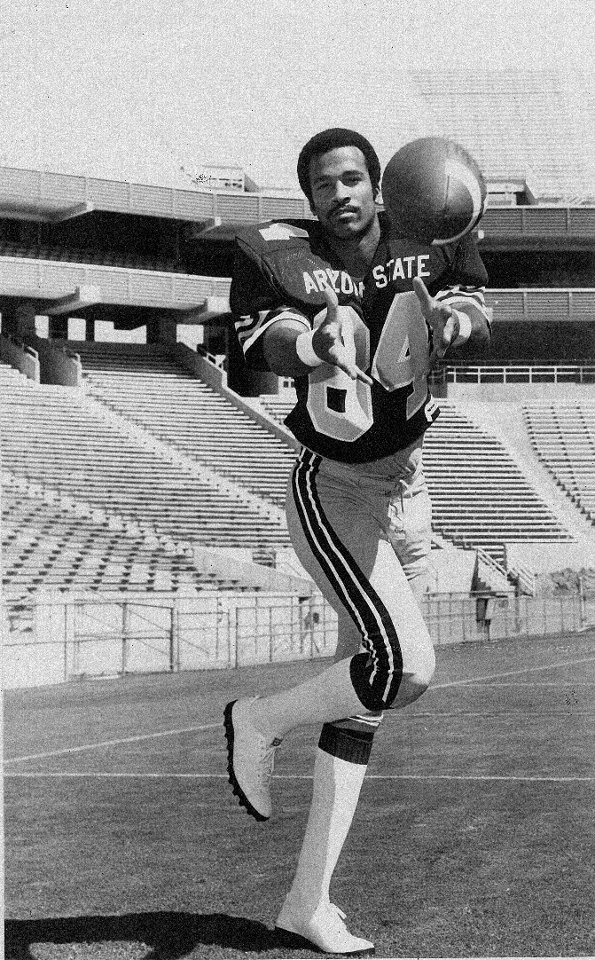
Ruth, meanwhile, was born in Michigan and grew up in Colorado, the daughter of parents who had earned master’s degrees, with her mother working as a teacher and her father as a chemist in a federal government position. She chose ASU to major in mass communications. “Let me say, both of us grew up with an expectation that we would go to college,” she reflects.
They might not have met had the football team’s training table not been located inside the cafeteria of her all-women’s freshman dorm. “I don’t know why they put it there, but I’m glad they did,” he says, smiling. They would often pass each other on the walkway to and from the dorm. “I thought he was cute,” she recalls. They met and started hanging out with friends in the lobby, and eventually began to date — a relationship that grew more serious as each year passed in college.
During this time, both Jerry and Ruth became acutely aware of an occurrence that was all too common. Friends or acquaintances would go home on break and, mysteriously, not come back to school. “Later, we’d find out that certain friends couldn’t come back because they didn’t have the financial wherewithal to pay for tuition that semester,” Jerry says. “And we both said that if we were ever in a position to help keep that from happening, we wanted to do that.”
The night they graduated, Jerry popped the big question and Ruth said yes. They knew they wanted to make a life together even though they were about to be separated geographically. And soon enough, they would be in a position to make good on their vow to make an impact.
***
Jerry headed to Tampa, where the playoff-contending Bucs selected him in the third round with the 74th overall pick of the draft. Rather than following him, Ruth charted her own course to Washington, D.C. to work in a lobbying firm that represented public employment agencies nationwide. “There was no doubt I wanted to marry Jerry but I wanted to experience life on my own for a while,” she explains. She worked in Washington for two years before the couple was married in her old hometown of Lansing in 1984, starting their new life together in Tampa.
While Jerry toiled through a string of 2-14 seasons, Ruth began building her career — earning her master’s in public administration at USF, starting as community relations manager at Tampa General, moving to Hillsborough County in the Office of Intergovernmental Affairs, and then going to work as a communications executive for LifeLink, an organization dedicated to the recovery and transplantation of organs and tissue.
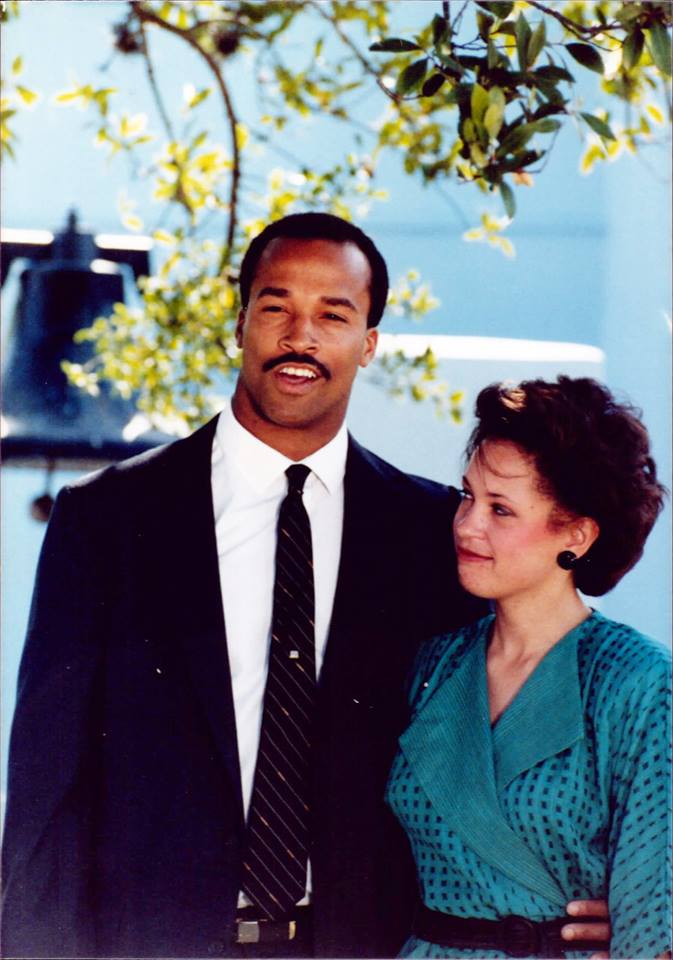
Her husband even found time during several off-seasons to get his MBA with a specialization in management at The University of Tampa. “I always played football with the understanding that I’d be doing something else professionally, and I wanted to prepare for it,” he says.
After retiring in 1987, Jerry went to work in sales for IBM. And it was only a matter of time before he and his wife began talking about starting an endowed scholarship. “It was really Ruth’s idea to get it going,” he says. The first step was talking to family friend and 1982 USF graduate Hiram Green, a former Bulls basketball star who today works as USF Health's director of community engagement. The couple expressed their interest in becoming involved with USF and Green encouraged them.
Ruth then spoke with Juel Smith, director at the time of USF's Institute on Black Life, about various initiatives taking shape. One of them was scholarships, and that was exactly what the Bells had in mind. They started the Ruth and Jerry Bell Endowed Minority Scholarship with a gift of $75,000, and it has been going strong ever since, with 46 recipients in the last 19 years alone. One of the newest recipients is sophomore engineering major Amber Imeh, who already has enough credits to qualify as a junior. She was ecstatic to learn she had received the scholarship for a very simple reason.
“This scholarship has helped me stay in school," she says. “I'm here all on scholarships, because my family doesn't have enough income to do anything for me. So I've worked hard with my grades up, and pursue my dream of becoming a a computer engineer. I haven't met the Bells yet, but when I do, I'm going to shake their hands. I don't even know if I'll be able to find words to express how much their scholarship means to me — I can go to college because of them.”
That is precisely what drives the Bells. “There are a lot of talented young people out there who might otherwise not have the opportunity to go to college,” Ruth says. “If we can contribute a little toward making a college education possible, that’s a wonderful feeling.”
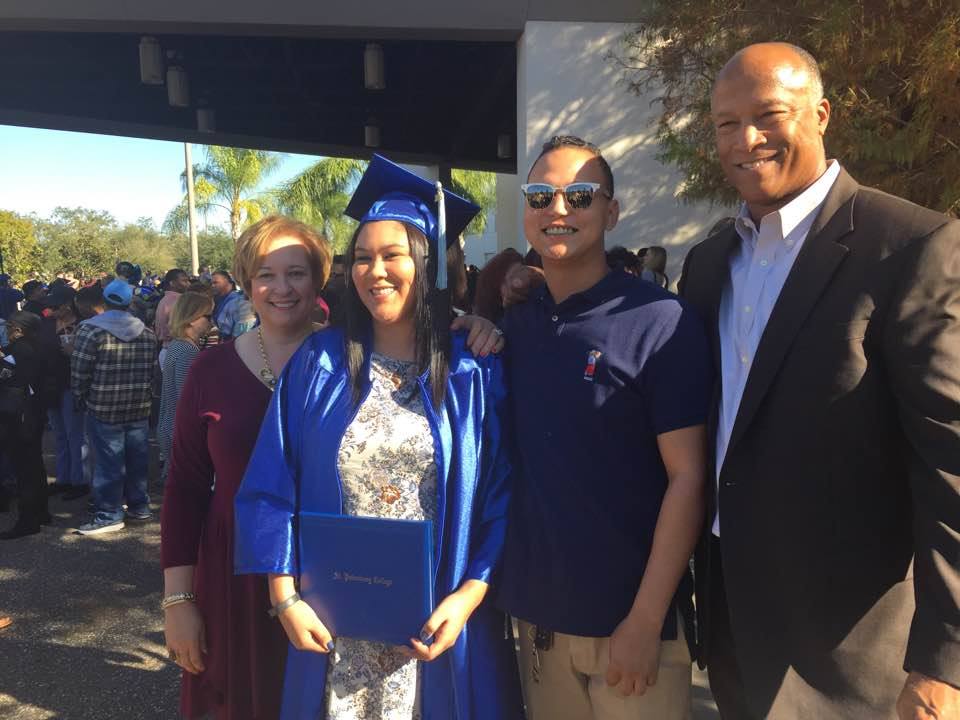
She and Jerry continue to feel enriched in many ways — from their daughter, who recently graduated from college with an education degree, and son, a business major soon to graduate from college. They love playing and cuddling with dogs Chloe and Astro. And they derive ongoing satisfaction from their jobs. Jerry runs his company — Bell IT — from home, while Ruth has celebrated 20 years at LifeLink.
A colorful, impressionistic painting of fish hangs in the kitchen by a heart transplant recipient named Wichie Torres, an acclaimed artist in Puerto Rico. Many of the other works in their home are by noted black artists — such as the bronze busts by nationally acclaimed sculptor Ed Dwight, the first African-American to be trained as an astronaut.
But some of their greatest joy comes from the knowledge they are helping students fulfill their potential. They don’t meet all of their scholarship recipients personally, though they always receive letters of gratitude. “It’s awesome to know who they are and what they’re doing with their lives,” Jerry says.
The truth is, most have no idea that the man who lent them a crucial helping hand once worked before weekly crowds of thousands in the NFL spotlight. And that’s perfectly fine with him. What matters is making a difference in the present, something the unbeatable team of Ruth and Jerry Bell has done with little fanfare, but more satisfaction than they ever dreamed.
